On the Way for Testing: Sony FE 24mm f/2.8 G, Sony FE 40mm f/2.5 G, Sony FE 50mm f/2.5 G
See yesterday’s discussion of the Sony 24/40/50mm primes. They cement Sony’s lead in mirrorless, IMO.
Perfect timing for my testing of the superlative Sony A1—after all the fun with Eye AF and Tigger, I now turn to image quality, usage (buttons and menus) and other good stuff.
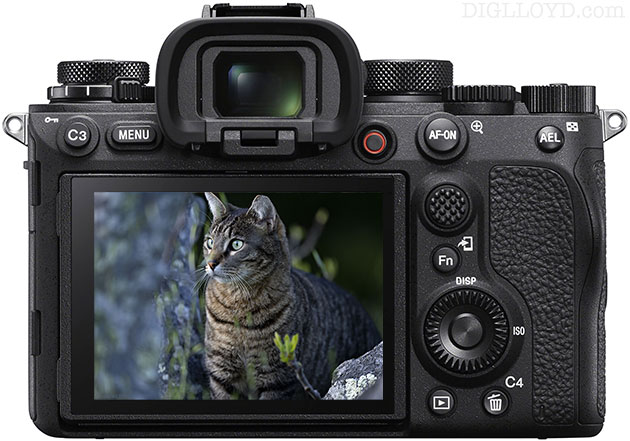
The 3 new diminutive and featherweight Sony G lenses have arrived for testing.
Sony FE 24mm f/2.8 G
Sony FE 40mm f/2.5 G
Sony FE 50mm f/2.5 G
My neural network with retinal input tells me that the Sony A1 image quality is the finest I’ve yet seen in any 35mm digital camera.
Maybe I can prove that and maybe not, but I keep finding myself thinking it as I review images. Something about the color rendition and richness of the images and cleanliness of the dark tones—medium format quality definitely at least in the the freedom from spikes and gapping in the dark tones. makes me wonder when this sensor technology will make into into Fujifilm medium format.
Even if the Sony A1 only matches the Sony A7R IV, the A1 is so incredibly responsive and the 9+ megapixel EVF so smooth and vivid that it’s going to be hard to go back*.
OTOH, Sony has made a few changes which I do not like, such as turning some functionality into physical dials, which force me to look at the top of the camera and to use a flashlight when it's dark, to see what I’m doing. I wish that could be overridden so I can just use the menu or .
* The EVF is so good that it’s almost a “problem”: images look awesome even if they’re not that perfect on the computer! But the pleasure factor while shooting is better than anything I’ve ever used.

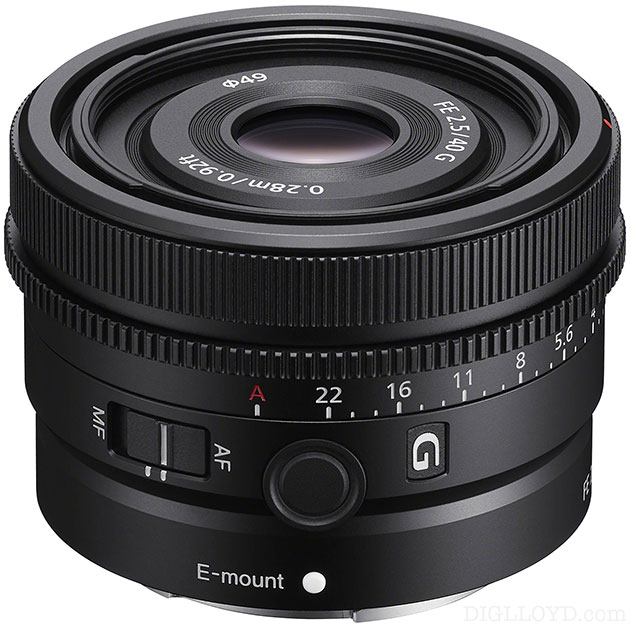
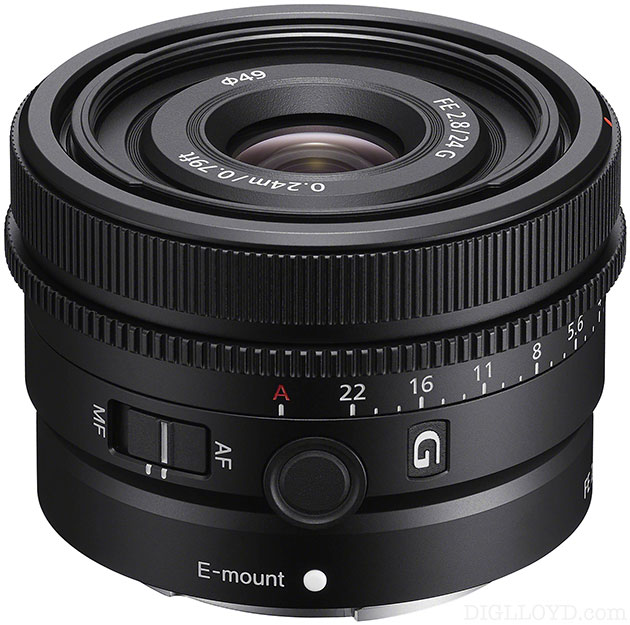
Sony FE 40mm f/2.5 G
Sony FE 24mm f/3.5 G
James W writes:
From the top, the three new lenses look too similar. The focal length should also be engraved on the top of the barrel, as Leica does, not just on the front. All lenses should have this, but this is especially important when, as with this new Sony trio, multiple focal length lenses have an almost identical appearance, making them difficult to tell apart at a glance.
(Also, the engraved focal length on the front of the barrel is hidden from view when mounted on a camera oriented normally when held in your hand (the front is not in your line of sight), the writing may be sideways or upside down when you orient a lens to read its front, and viewing the engraving on the front may be made more difficult by an attached lens hood and/or filter (especially if you need to look through dark glass to see the engraved focal length). The engravings on the fronts of lenses are also not in a standardized format, nor do they typically show the focal length separated from other information, so you can't tell the focal length at a glance, you have to read through other information.)
I'm reminded of user interface expert, Don Norman's story that the operators of a nuclear reactor control room replaced the supplied identical control handles that all looked alike with all different distinctive beer brand handles to avoid mistakes.
DIGLLOYD: good points. And the focal length is there right on the lens at about 90° from the G as shown below. Admittedly is is not “on top”, but I know what lens is on the camera. Super nicely done here IMO, with a big engraged number for the focal length. OK, I’ll quibble a bit: bright neon green would be easier to see in dim conditions perhaps.
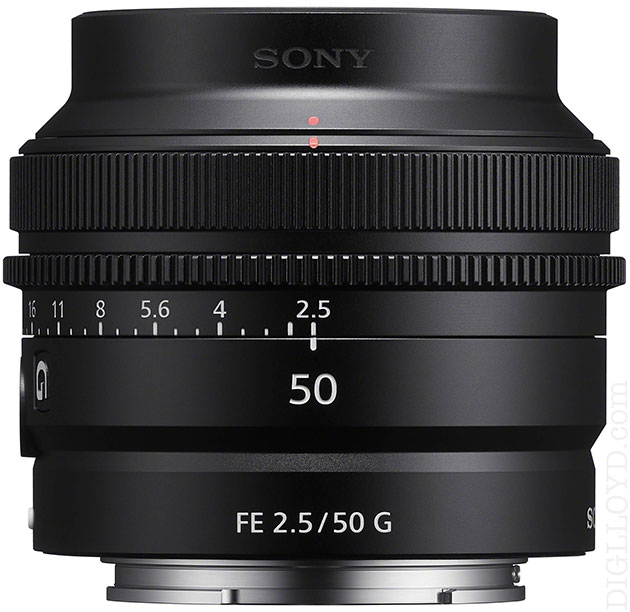
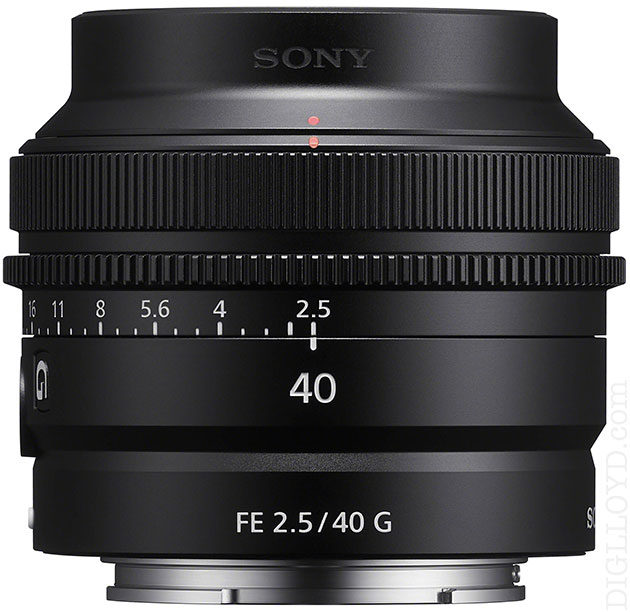

Sony FE 40mm f/2.5 G
Sony FE 24mm f/3.5 G
Claude F writes:
As luck would have it I am on the cusp of deciding between a new Sony or Fujifilm GFX100S.
Your new Sony lens tests could have tremendous bearing on my decision. If at all possible take the lenses to the aperture where they are sharp, ignoring the effects of diffraction. As you point out, if the new lenses prove to be strong performers and there is a possibility of the line expanding the camera and lens combination could make the Sony platform unbelievable for several applications.
DIGLLOYD: of course I’ll show aperture series with these lenses. I expect them to be maximally sharp in the f/4 to f/5.6 range; after that as with all good lenses, diffraction will steadily dull things.
Chuck T writes:
I have issues with the discussion on pancake lens. I remember reading about Galen Rowell lens he carried climbing Yosemite. He loved taking 3 "pancake type lens" to keep the weight down. But his range of lens was much wider than 23/40/50mm. I also don't like to see 2-3 closely spaced pancake lens since it is easier to use the 24-70mm f/2.8 zoom (or equivalent) to get as good performance with NO LENS CHANGES in dangerous (or wet/dusty/dirty) places. Just taking a 24mm with an 80mm and a longer (150/200/300) lens seems much more practical.
Maybe I misread your intention and you did not think about taking 3 close pancake lens at all! I feel that the lens like 24-105mm f/4 (or Nikon's 24-120mm f/4 version) are terrific to carry around nearly everywhere since you would only be changing lens for a much wider option or a much longer option. These 24-105mm lens are always my first purchase for a new camera body/system AND/OR a Christmas gift for a brother or sister-in-law or niece/nephew. I get praise for years when they realize what a gift they really received!
GALEN STATED "Some of his best images could have probably been made with only a 24mm f/2.8 and an 80-200 zoom (he liked 2 versions, f/2.8 or f/4.5-5.6). Note Sony's 24-105mm f/4 weighs ~660grams too (I'll admit to the loss in one or more f-stop for this choice).
DIGLLOYD: just because I need a screwdriver does not mean a hammer is better because my neighbor is roofing today, and I am not. So it goes for the use cases, for arbitrary preferences, etc.
From 2010, and it still holds as great advice: Shoot One Lens, and Not a Zoom
While there is a lot of truth to the above, there are also a ton of considerations left out. I have no counter-argument for anyone who after considering all factors objectively chooses a zoom, or who just wants the (IMO false) simplicity. Because reasoned considerations by definition have no “better”. But when the "argument" stems from ignoring context and fact-dropping to get to that preference it’s foolish (not saying Chuck T is doing so, just saying in general).
It all depends.
IMO, for quality image making a 24mm + 40mm or 50mm (pick your focals) is a fine combination that forces the photographer to think clearly about the artistic vision. For myself and for others I claim that better images usually result from prime lenses, not because primes are better optically, but because it forces attention to perspective and artistic visions. Zooms can make you compositionally lazy. I have to explicitly remind myself of this every time I use one... what about a more causal shooter?! A zoom too easily becomes an opportunity for marginal compositions by not choosing perspective. OTOH, sometimes you cannot walk over the cliff or back up any more. And if you’re shooting weddings and stuff, sure, of course. Or Tigger is running all over the place... but that non-zoom 0/4 did a damn fine job.
Maybe you’d do even better with two primes ? Did my Dec 2021 Eureka Dunes images suffer from not having a zoom on the Leica M10 Monochrom? Nope, and I think I got better images by shooting most of them with a 24mm and 35mm.
It all depends.
For practicality, the idea of riding my mountain bike to White Mountain Peak with a 24-70/2.8 is awkward/unwieldly and totally unnecessary, though a 24-70/4 might work. A compact lens with another focal is plenty for such a case, particularly with lenses this small—and far more enjoyable and I won’t have to put the camera in my bacpack at times, as with the zoom. They’re so small I could fit five of them in just the outer pocket of my pack, not that I advise that. Hiking up the Mountaineer’s Route of Mt Whitney? I’ll take the Sony FE 12-24mm f/2.8 GM and a 40mm or 50mm because I can cover everything important with just that,
Dust... that's not a real argument 99% of the time. excuse. In all the times I've shot outdoors, this is just not a real reason.... conditions that bad are a health hazard or problematic just from the wind. So take a zoom if you operate in such conditions and really have to shoot in that stuff. But in all these years of months in the field, I think that one is a red herring. And... many zooms suck in dust by zooming!
Then there is mis-comparing aka comparing the wrong things: pro/serious use to ad-hoc personal snapshots, unsharp film days to unforgiving high-res digital, a tiny lens to one three times the size and fitting to frame vs perspective choices, etc. Need I go on?
As for when zooms are best, I’d say that 12-24mm and super tele zooms are clear need-driven exceptions.
Optical performance is a factor too: I've never been satisfied with the performance of any 24-70 or 24-105 zoom and high-res digital is unforgivint. And zooms have pretty bad distortion at the ends which needs distortion correction, and that further degrades things, which is not exactly great for stitching. Shooting at lake dusk? F/4 is often problematic, so f/2.5 or f/2.8 is a big help, if only for focusing.
As for Galen Rowell (I knew him fairly well), he was primarily a climber and it made total sense to use a zoom in difficult cases. But his life might have been a lot easier with the Sony primes!
Eeraj Q writes:
Re. Zoom vs. Primes and the comment on Galen Rowell and his lens choices. My take is that if the conditions are so hazardous that a lens change is impossible and one still desires top quality, take a small prime and call it a day. There are other more important things to worry about on a slippery, wet mountain hike than trying to fiddle with a zoom. As you point out, your work with the M10M + the 24 Elmar and ZM 35 F1.4 shows the power of small primes.
Your "Climbing Mt Dana" series with the Leica Q is another great example of a single focal length put to excellent use with images that draw the viewer in. Solid images, great colors in that series. No zoom needed.
Continuing the zoom vs prime thread - take a FF body + a small prime (or a Leica Q or similar) in your favorite focal length and throw in a Sony RX100 VI for longer tele shots on hikes where every gram counts. The RX100 VI is a gem with an astounding IQ/(weight, size) ratio, 24-200 in your pocket with IQ that can rival larger sensors when used within its limits.
Good work, eager to see more.
DIGLLOYD: I’d favor the Sony RX100 VA myself—shorter 24-70mm (equiv) zoom range, but f/1.8-2.8 is much more usable in dim conditions.






























